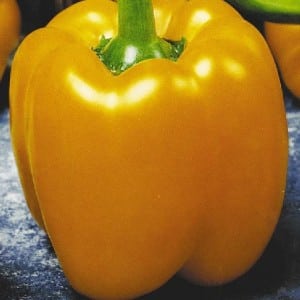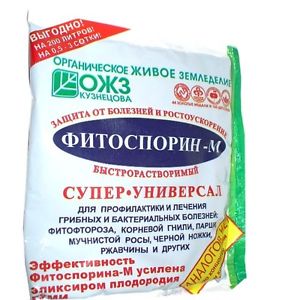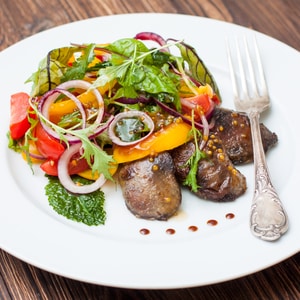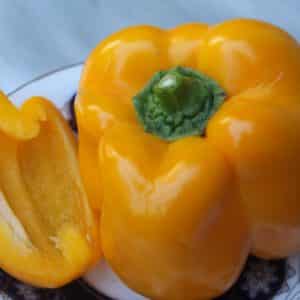One of the best types of bell pepper - “Golden Calf”: an overview of the variety and its characteristics
Gardeners all over the country love the Golden Calf bell pepper. Some value it for its ease of care, others for its sweet and juicy taste. Delicious preparations are made from pepper, which are useful for vitamins A and B. And in terms of vitamin C content, it is not inferior to lemon and black currant.
Let's take a closer look at what the Golden Calf sweet pepper variety is and how to grow a rich harvest on your site.
Characteristics and description of the variety
The golden calf was bred by breeders from Siberia, therefore it has high immunity to unpredictable climate and common diseases. Peppers are grown in open ground, greenhouses or greenhouses.
The mid-season variety produces a harvest 100-110 days after planting. The bushes are low-growing and compact, the leaves are classic green. The golden calf is planted in seedlings or without seedlings; organic matter or mineral complexes are used as fertilizing. The fruiting period is extended, which allows you to enjoy delicious peppers for as long as possible.

Productivity and fruits
The fruits are large, weighing from 250 to 500 g per one. They have a slightly ribbed glossy surface and a rich yellow-orange color (see photo). There are few seeds, the pulp is very juicy and sweet.
Pepper has a high shelf life and can be stored for a long time. From one bush, summer residents remove from 10 to 14 large and beautiful fruits.
Preparation for cultivation
To obtain a high-quality harvest, gardeners prepare seeds: they carry out disinfection, germination and hardening. To understand which seeds are of the highest quality, they are tested for germination. Pour the seeds into a jar of water and stir the water with a spoon. Those seeds that sank to the bottom of the jar are planted, and the rest are thrown away.
Disinfection is carried out using aloe juice or hydrogen peroxide, in which the seeds are left for a day. The products destroy dangerous microbes on the surface of seeds and reduce the risk of developing diseases.
Next, they are germinated by placing them in a damp gauze bag. Sprouting helps seeds adapt to external conditions and improve immunity. 1-2 weeks before planting, the seed is hardened by placing it in the freezer for an hour every day. Thanks to hardening, the Golden Calf can easily withstand frost, rain and fog.
Important! Experienced summer residents advise preparing beds for peppers in the fall. To do this, dig up the soil and fertilize it with peat or humus. With the arrival of spring, the beds are dug up again, straw is laid on them and sprinkled with river sand. Golden Calf pepper is planted in sunny and well-warmed areas.
How to plant seedlings
To ensure a successful harvest, seedlings are prepared. This requires a container and soil. Any clean container is suitable as a container: flower pots, egg nets or plastic boxes. Prepared soil is poured into them and small grooves are made.
The distance between seedlings should be at least 10 cm. Immediately after planting, the seedlings are watered with settled water at room temperature.
Important! Soil from the garden or ready-made mixtures are used as soil. There is no consensus on which is better.Regardless of the composition and quality, the soil is disinfected with a manganese solution, and all debris (remains of past plants, twigs, larvae) is removed from the soil.
Seedlings are usually placed on a windowsill where there is plenty of sunlight. At first, the container is covered with thin glass or cling film, which is removed after 5-7 days. This makes it easier for plants to adapt. To accelerate growth, stimulants and liquid organic fertilizers are added to seedlings. Fitosporin, bird droppings, and nettle solution are recognized as excellent remedies.

Water the Golden Calf variety regularly, every 3-4 days. For convenient watering, use a pipette, with which water gets directly under the root, and not on the leaves. Fertilize seedlings every 15-20 days. Wood ash, Bordeaux mixture or copper sulfate solution are used as fertilizer. The products not only strengthen the plant, but also serve as the prevention of many diseases.
Important! After two weeks, gardeners plant (transplant) the seedlings into a larger container. This is due to the fact that the root system is developing and needs more free space. When picking, it is important not to damage the thin and still weak roots of the bell pepper.
Planting peppers in open ground
Plant the Golden Calf pepper on a dry and windless day. Before planting, water the beds generously with warm water to make the soil soft and moist. The sprouts are placed 15-20 cm deep into the ground, the distance between the bushes is at least 30 cm.
Before planting, the shovel and other tools are disinfected with a manganese solution to prevent fungal infections.
Caring for sweet peppers
Caring for peppers does not require special knowledge or skills. This is another plus of the variety. To get a tasty harvest, you need:
- Water the beds every 5-7 days. On average, one bush requires 1-1.5 liters of water. Summer residents recommend using rainwater rather than tap water.
- Weed the beds once a week, remove weeds and loosen the soil. These procedures are necessary to make the soil more airy and nutritious.
- Fertilize the plant once every two weeks. Pepper reacts positively to mineral complexes, for example, the drug “Tsitovit”. It reduces the fall of ovaries, increases productivity, and prevents diseases.
Features of cultivation and possible difficulties
During the growing process, beginning gardeners may encounter a number of problems. Therefore, more experienced gardeners recommend:
- Water the peppers sparingly, without over-moistening the soil. Excess moisture can lead to the appearance of fungi and viruses.
- Loosen the soil to a maximum depth of 10-15 cm so as not to damage the roots.
- Water the beds in the early morning or evening when there is no sun.
- Remove weeds after each watering or rain.
- Spray the bushes with soapy water or Bordeaux mixture 2-3 times per season.
- Form bushes. As soon as 10 leaves form on the stem, cut off the side shoots.
Read also:
How to cook Ratunda pepper with honey for the winter: preservation recipes.
How to prepare pickled tsitsak peppers for the winter.
What's good about the Winnie the Pooh pepper: let's get to know the variety.
Typical diseases and pests
Among the pests, the beds with sweet peppers are attacked by the spider mite, which, thanks to its web, sucks vital substances from the bushes. For prevention, summer residents use soap sprays, and if the bug has already appeared, they use the effective drug “Maxim”. In addition to mites, Colorado potato beetles, aphids, and mole crickets are also found in the garden.A solution of copper sulfate helps fight pests.
It happens that the Golden Calf gets brown spot. It appears due to contaminated soil or improper care. They fight brown spot with the help of the drug “Zaslon”, which is used in strict accordance with the manufacturer’s recommendations and dosages.
Important! The most common disease is late blight. It is a fungal infection that appears as brown and yellow spots on the leaves. It is very difficult to treat late blight; it is easier to prevent its occurrence with proper care and ash fertilizers.
Advantages and disadvantages of the variety
The main advantages of the variety are its taste and appearance. Gardeners actively use the sweet vegetable in cooking: they prepare soups, summer salads, and cold appetizers. In addition, sweet peppers are indispensable in proper and dietary nutrition; they make tasty and healthy nutritious side dishes. Thanks to its bright and appetizing color, the Golden Calf pepper will decorate any holiday table. 
Pepper has high immunity, rarely gets sick, and can easily tolerate a long absence of sun and water. It is grown both in the south of the country and in Siberia.
It shows high and stable yields, is stored for a long time, and can be transported over long distances without problems.
Pepper has no significant disadvantages. Some gardeners don’t like the fact that the bushes need shaping. Otherwise, the Golden Calf has no disadvantages.
Reviews
Mostly there are rave reviews from gardeners who love the Golden Calf pepper and regularly plant it. However, there are also less flattering comments.
Marina, Novosibirsk: «I love large-fruited vegetables, and the Golden Calf variety is no exception.I’ve been growing it for three years now and I’m happy with the harvest. Requires minimal maintenance."
Alexey, Saratov: «Of all the varieties, Golden Calf is my favorite. It has delicious pulp, very juicy and tasty. I cook different dishes and eat them fresh. I recommend it to all gardeners."
Irina, Cheboksary: “I planted the seeds in open ground, thinking that the hybrid would take root just like that. However, the sprouts developed slowly, although the soil was fertilized according to all the rules. The harvest turned out to be average, the taste is no different from most other sweet varieties.”
Conclusion
Bell peppers are loved by many and are valued for their taste and versatility. The best vegetable is the one grown on your own plot. The Golden Calf pepper grows large and beautiful, and caring for it is easy and simple. It needs regular watering and fertilizing, which serve as the key to a rich harvest.
Many people consume bell peppers not only fresh, but also frozen for the winter. To do this, cut it into small cubes, wrap it in a plastic bag and put it in the freezer.